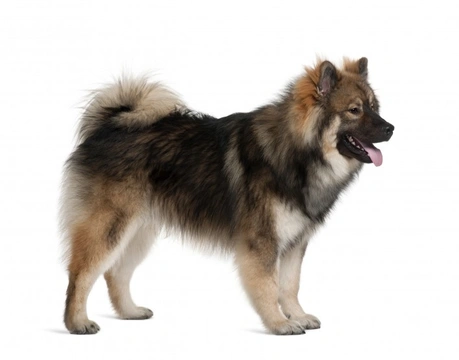
Dandy-Walker-Like malformation in the Eurasier dog breed
The Eurasier is a medium-sized dog breed of the spitz type, which is recognised within the Kennel Club’s utility grouping. Also sometimes known as the Eurasian dog, Eurasiers originated in Germany and aren’t hugely common within the UK although there are a lot of plus points to the breed that make them worth considering by those seeking a new dog to join their homes.
Eurasiers are very loyal and loving dogs that form strong bonds with their owners and work hard to please them, and this makes dogs of the breed very amenable to training and a good choice of pet for even first-time dog owners.
They are also good with children, generally well mannered and well behaved, and capable of staying on their own happily for a few hours at a time without becoming destructive.
However, they are also very energetic and lively dogs that need a lot of exercise that is varied, fun and challenging to keep the dog occupied, entertained and happy. They’re quite heavy shedders like many dogs of the spitz type, which means that they need a lot of brushing and grooming to keep their coats in good condition.
Eurasier dogs have an average lifespan of 11-13 years, and they are not one of the pedigree dog breeds that have a huge list of hereditary health problems recognised within the breed that can threaten the health of individual dogs and the breed as a whole.
However, there are still a number of conditions for which the Eurasier has elevated risk factors, and some of these can be identified in adult dogs of breeding age prior to making a mating match by using DNA testing, so that breeders can make an informed decision about breeding healthy litters.
One such condition is called Dandy-Walker-Like malformation, and this is a condition that leads to abnormal brain development in some dogs of the breed that inherit a certain genetic mutation.
In this article we will look at Dandy-Walker-Like malformation in the Eurasier dog breed in more detail, covering how it affects dogs, how it is passed on from parent dogs to their young, and how to get a Eurasier DNA tested for Dandy-Walker-Like malformation. Read on to learn more about Dandy-Walker-Like malformation in Eurasier dogs.
What is Dandy-Walker-Like malformation?
Dandy-Walker-Like malformation gets its name because a very similar condition called Dandy-Walker syndrome can be found in humans, and both the human and the canine variant of the condition are caused by a genetic mutation that causes the brain of the affected party to develop abnormally.
Dandy-Walker-Like malformation in the Eurasier begins with a form of ataxia or lack of muscular coordination, and this can be highly variable in terms of its severity and impact on individual dogs with the condition.
Some dogs will exhibit only a mild lack of normal coordination and gait abnormalities, whilst others may have a much more acute form of the condition, which involves extreme ataxia that can cause the dog to fall over, be unable to move around normally, and generally have problems navigating and walking normally. Seizures may also develop in some Eurasiers with Dandy-Walker-Like malformation too.
The type of ataxia that Dandy-Walker-Like malformation causes in Eurasier dogs isn’t progressive, which means that dogs with the condition don’t usually suffer from a gradual worsening of symptoms as the condition develops.
Generally, Dandy-Walker-Like malformation in Eurasiers presents with symptoms for the first time while the affected dog is still young, often just a few weeks old and still nursing from their dam.
How is Dandy-Walker-Like malformation passed on from dog to dog?
Dandy-Walker-Like malformation is an inherited health condition, which means that only if a dog inherits the gene mutations that causes it from their parents will they have a chance of being affected by the condition themselves.
Dandy-Walker-Like malformation is passed on through a dog’s lineage by means of autosomal recessive heredity, which means that whether or not a pup is affected by the condition depends on the status of both of their parents, not just one. A dog is assigned with a status of either clear, carrier or affected, and knowing the status of the parent dogs enables you to work out the status of the pups in any litter they might have too.
- Two clear parent dogs will have a clear litter.
- Two affected parent dogs will have an affected litter.
- Two carrier parent dogs will produce a litter of 50% carriers, 25% clear and 25% affected.
- A clear dog and an affected dog will have a litter of carriers.
- A clear dog and a carrier will have 50% clear and 50% carrier pups.
- A carrier and an affected dog will have 50% carriers and 50% affected pups.
DNA testing for Dandy-Walker-Like malformation in the Eurasier dog
Eurasier dog breeders can have their dogs health tested prior to breeding from them to find out the status of their parent dogs and so, the status of their future litter. This is performed with a simple DNA test, and to get your dog tested for Dandy-Walker-Like malformation, you just need to ask your vet to take a DNA sample from your dog and send it off to an authorised laboratory for testing to get the results.
If you are thinking of buying a Eurasier puppy, talk to the breeder you are considering buying from to find out if there have been any presentations of Dandy-Walker-Like malformation within their breed lines, and ask to see the results of any health tests performed before committing to a purchase.



